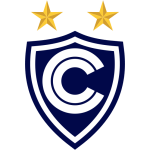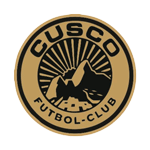| Coach | NA |
| Venue | Estadio Inca Garcilaso de la Vega |
Cienciano Trivia
Cienciano predictions
Predictions for Cienciano: See upcoming and historic predictions for Cienciano below.
Disclaimer: Past performance does not guarantee future results. Betting involves risk; only wager what you can afford to lose. Always gamble responsibly.
Cienciano Opinions
 Who scored the winning goal in the 2003 Copa Sudamericana final?
Who scored the winning goal in the 2003 Copa Sudamericana final?
Cienciano latest results
| 12/04 | - | ||
| 06/04 | - | ||
| 26/02 | 1 - 2 | ||
| 18/02 | 3 - 2 | ||
| 09/02 | 2 - 2 |
Primera División standings
| Rank | Team | MP | W | D | L | GF | GA | GD | Pts |
|---|---|---|---|---|---|---|---|---|---|
| 1 |
 ADT
ADT
|
0 | 0 | 0 | 0 | 0 | 0 | 0 | 0 |
| 2 |
 Alianza Atletico
Alianza Atletico
|
0 | 0 | 0 | 0 | 0 | 0 | 0 | 0 |
| 3 |
 Alianza Lima
Alianza Lima
|
0 | 0 | 0 | 0 | 0 | 0 | 0 | 0 |
| 4 |
 Atletico Grau
Atletico Grau
|
0 | 0 | 0 | 0 | 0 | 0 | 0 | 0 |
| 5 |
 Carlos A. Mannucci
Carlos A. Mannucci
|
0 | 0 | 0 | 0 | 0 | 0 | 0 | 0 |
| 6 |
 Cienciano
Cienciano
|
0 | 0 | 0 | 0 | 0 | 0 | 0 | 0 |
| 7 |
 Comerciantes Unidos
Comerciantes Unidos
|
0 | 0 | 0 | 0 | 0 | 0 | 0 | 0 |
| 8 |
 Cusco
Cusco
|
0 | 0 | 0 | 0 | 0 | 0 | 0 | 0 |
| 9 |
 Cesar Vallejo
Cesar Vallejo
|
0 | 0 | 0 | 0 | 0 | 0 | 0 | 0 |
| 10 |
 Deportivo Garcilaso
Deportivo Garcilaso
|
0 | 0 | 0 | 0 | 0 | 0 | 0 | 0 |
| 11 |
 Cultural Santa Rosa
Cultural Santa Rosa
|
0 | 0 | 0 | 0 | 0 | 0 | 0 | 0 |
| 12 |
 FBC Melgar
FBC Melgar
|
0 | 0 | 0 | 0 | 0 | 0 | 0 | 0 |
| 13 |
 Sport Boys
Sport Boys
|
0 | 0 | 0 | 0 | 0 | 0 | 0 | 0 |
| 14 |
 Sport Huancayo
Sport Huancayo
|
0 | 0 | 0 | 0 | 0 | 0 | 0 | 0 |
| 15 |
 Sporting Cristal
Sporting Cristal
|
0 | 0 | 0 | 0 | 0 | 0 | 0 | 0 |
| 16 |
 UTC
UTC
|
0 | 0 | 0 | 0 | 0 | 0 | 0 | 0 |
| 17 |
 Universitario
Universitario
|
0 | 0 | 0 | 0 | 0 | 0 | 0 | 0 |
| 18 |
 Union Comercio
Union Comercio
|
0 | 0 | 0 | 0 | 0 | 0 | 0 | 0 |
About Cienciano
Cienciano is a renowned Peruvian football club based in Cusco, the historic capital of the Inca Empire. Founded on November 8, 1901, it is one of the oldest football clubs in Peru. The club's name, Cienciano, is derived from the National College of Science (Colegio Nacional de Ciencias) in Cusco, where the founding members were students.
The club is popularly known as "El Papá" or "The Father," a nickname earned due to its long-standing presence in Peruvian football. The team's colors are red and white, reflecting the vibrant spirit of the city of Cusco. The home games are played at the Estadio Inca Garcilaso de la Vega, which has a seating capacity of over 42,000 spectators.
Cienciano's journey in the football world has been marked by significant achievements and challenges. The club spent most of the 20th century in the Peruvian Segunda División, the second tier of Peruvian football. However, they gained promotion to the top-flight Peruvian Primera División in 1973 and have since established themselves as a competitive force in Peruvian football.
The club's golden era came in the early 2000s when they achieved remarkable success on the international stage. In 2003, under the guidance of coach Freddy Ternero, Cienciano won the Copa Sudamericana, becoming the first Peruvian club to win an international competition. The following year, they added another feather to their cap by winning the Recopa Sudamericana, defeating Argentine giants Boca Juniors.
Despite these successes, Cienciano faced financial difficulties that led to their relegation to the Segunda División in 2015. However, they returned to the Primera División in 2020 after winning the Liga 2 title.
Over the years, Cienciano has produced several notable players who have represented the Peruvian national team. These include Julio García, Germán Carty, and Paolo de la Haza. The club has also been home to foreign players who have left a significant impact, such as Argentine striker Sergio Ibarra, who is the club's all-time leading scorer.
Cienciano's history is not just about football; it is also about representing the rich cultural heritage of Cusco and the Inca civilization. The club's emblem features a sun, which is a significant symbol in Inca culture, and their mascot, a llama, is a native animal of the Andean region.
Despite the ups and downs, Cienciano remains a beloved institution in Peruvian football, known for its passionate fan base and its commitment to promoting football in the region. The club's journey, marked by resilience and determination, continues to inspire future generations of footballers in Peru and beyond.















